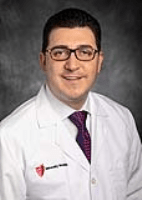
13 Feb Stroke: Thrombectomy Improved Functional Outcomes Overall and Across Different Subgroups
MedicalResearch.com Interview with:

Dr. Sarraj
Amrou Sarraj, MD FAHAProfessor of Neurology, Case Western Reserve University School of MedicineGeorge M. Humphrey II Endowed Chair, University Hospitals Neurological Institute
Director, Comprehensive Stroke Center and Stroke Systems, University Hospitals
MedicalResearch.com: What is the background for this study? What are the main findings?
Response: Endovascular thrombectomy was proven safe and effective in patients with acute ischemic, stroke, neurologist, occlusion presenting up to 24 hours from last known well in multiple clinical trials. Patients with large ischemic changes were largely excluded from those trials, and thus limited randomized evidence of thrombectomy in this patient population exists.
Our study found that thrombectomy improved the odds of achieving better functional outcomes by 1.5 times in patients with large ischemic changes on non-contrast CT or perfusion imaging. Proportion of patients achieving functional independence (mRS 0-2) and Independent ambulation (mRS 0-3) were also significantly higher with thrombectomy. Symptomatic hemorrhage occurred in very few patients and was not higher with thrombectomy. Results from analyses of subgroup based on clinical and imaging characteristics were also largely similar to those of primary analysis.
MedicalResearch.com: What should readers take away from your report?
Response: We observed that thrombectomy improved functional outcomes overall and across different subgroups in patients from North America, Europe and Australia and New Zealand. With available results of RESCUE Japan LIMIT trial showed better rates of independent ambulation in patients with large ischemic strokes and ANGEL ASPECT trial in China, I believe we have enough evidence to support thrombectomy procedure in this patient population.
MedicalResearch.com: What recommendations do you have for future research as a results of this study?
Response: Endovascular thrombectomy has been proven one of the most effective treatment in the history of medicine. With the results of our trial, one more frontier has been conquered to extend the treatment to thousands of patients with larger strokes who may benefit. Optimization of health care systems and enhancing thrombectomy delivery should be a priority to offer this potent intervention to more patients. Optimization of patients’ care post thrombectomy, care transition and rehabilitations delivery would be vital to improve patients’ outcomes.
MedicalResearch.com: Is there anything else you would like to add? Any disclosures?
Response: SELECT and SELECT2 trials were investigator-initiated studies funded by research grants from Stryker Neurovascular to University Hospitals Cleveland Medical Center and UT McGovern Medical School. In addition, Dr Sarraj was an advisory board and speaker bureau member for Stryker Neurovascular and an advisory board member for AstraZeneca.
Citation:
Trial of Endovascular Thrombectomy for Large Ischemic Strokes A. Sarraj, A.E. Hassan, M.G. Abraham, S. Ortega‑Gutierrez, S.E. Kasner, M.S. Hussain, M. Chen, S. Blackburn, C.W. Sitton, L. Churilov, S. Sundararajan, Y.C. Hu, N.A. Herial, P. Jabbour, D. Gibson, A.N. Wallace, J.F. Arenillas, J.P. Tsai, R.F. Budzik, W.J. Hicks, O. Kozak, B. Yan, D.J. Cordato, N.W. Manning, M.W. Parsons, R.A. Hanel, A.N. Aghaebrahim, T.Y. Wu, P. Cardona‑Portela, N. Pérez de la Ossa, J.D. Schaafsma, J. Blasco, N. Sangha, S. Warach, C.D. Gandhi, T.J. Kleinig, D. Sahlein, L. Elijovich, W. Tekle, E.A. Samaniego, L. Maali, M.A. Abdulrazzak, M.N. Psychogios, A. Shuaib, D.K. Pujara, F. Shaker, H. Johns, G. Sharma, V. Yogendrakumar, F.C. Ng, M.H. Rahbar, C. Cai, P. Lavori, S. Hamilton, T. Nguyen, J.T. Fifi, S. Davis, L. Wechsler, V.M. Pereira, M.G. Lansberg, M.D. Hill, J.C. Grotta, M. Ribo, B.C. Campbell, and G.W. Albers, for the SELECT2 Investigators*
This article was published on February 10, 2023, at NEJM.org. DOI: 10.1056/NEJMoa2214403 https://www.nejm.org/doi/pdf/10.1056/NEJMoa2214403
The information on MedicalResearch.com is provided for educational purposes only, and is in no way intended to diagnose, cure, or treat any medical or other condition. Always seek the advice of your physician or other qualified health and ask your doctor any questions you may have regarding a medical condition. In addition to all other limitations and disclaimers in this agreement, service provider and its third party providers disclaim any liability or loss in connection with the content provided on this website.
Last Updated on February 13, 2023 by Marie Benz MD FAAD
